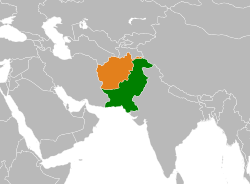| Bajaur Campaign | |||||||
|---|---|---|---|---|---|---|---|
| Part of the Afghanistan–Pakistan border conflict and the Cold War | |||||||
 Location of Afghanistan (orange) and Pakistan (green) | |||||||
| |||||||
| Belligerents | |||||||
|
Supported by: |
Supported by: | ||||||
| Commanders and leaders | |||||||
|
|
| ||||||
| Units involved | |||||||
|
|
| ||||||
| Strength | |||||||
| ~1,000 (claimed)[2] | Unknown | ||||||
The Bajaur Campaign was an armed conflict between Afghanistan and Pakistan that began in September 1960[4] and ended in September 1961. It primarily took place in and around Bajaur District in Pakistan's Federally Administered Tribal Areas. Hostilities broke out after Afghan prime minister Mohammad Daoud Khan, who was a vocal opponent of the Durand Line, sent in the Royal Afghan Army to occupy strategic regions in what is now Khyber Pakhtunkhwa, which is considered to be an essential part of the Pashtun homeland.[5] Ultimately, the Afghan invasion was brought to a halt following Pakistani airstrikes in Afghanistan's Kunar Province.[3][1] The Bajaur Campaign may have been a proxy conflict of the Cold War, as it has been alleged that the Afghans and the Pakistanis were actively receiving support from the Soviet Union and the United States, respectively.
As a result of the Bajaur Campaign, Afghanistan–Pakistan relations deteriorated to an all-time low; their relationship had already been marred by tensions immediately after the creation of Pakistan in August 1947, as the Afghan government had been contesting the Durand Line, which Pakistan had inherited from British India. The two countries severed their diplomatic ties with each other and bilateral trade ceased for 18 months. Following Khan's forced resignation from the Afghan prime ministerial position, Afghanistan and Pakistan began talks for rapprochement in an effort that was jointly supervised by American president John F. Kennedy and Iranian king Mohammad Reza Pahlavi.[6][1] Khan later returned to power as Afghanistan's president through the 1973 coup d'état, marking the beginning of the ongoing Afghan conflict.
- ^ a b c Riedel 2014.
- ^ a b c "Jun 1961 – 'Pakhtoonistan' Dispute. – Military Operations in Frontier Areas. – Pakistani Allegations of Afghan Incursions" (PDF). Keesing's Record of World Events. Retrieved 20 June 2022.
- ^ a b Wahab, Shaista; Youngerman, Barry (2007). A Brief History of Afghanistan. Infobase Publishing. p. 123. ISBN 978-0-8160-5761-0.
- ^ Cite error: The named reference
Forgotten Historywas invoked but never defined (see the help page). - ^ Blood, P.R.; Baxter, C.; Dupree, N. Hatch; Gouttierre, T.E.; Newell, R.S. (2001). "Afghanistan: A Country Study". In Gladstone, Cary (ed.). Afghanistan Revisited. New York: Nova Science Publishers, Inc. p. 111. ISBN 1-59033-421-3.
- ^ Says, Rahmat Hamid (15 February 2010). "Mohammad Daud Khan". The Khaama Press News Agency.
© MMXXIII Rich X Search. We shall prevail. All rights reserved. Rich X Search
